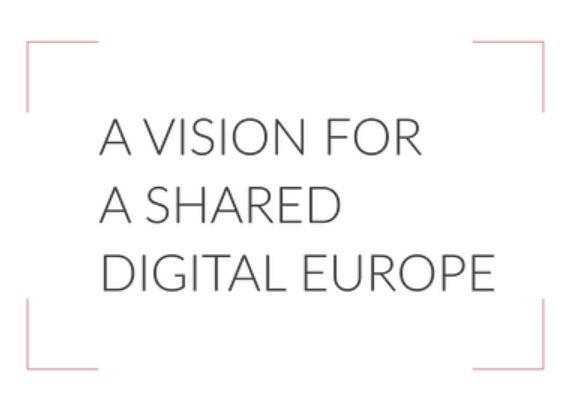How do we create public-civic spaces online? What role can ‘interoperability’ play? How could we transform the internet into something less exploitative, and more social and generative? In this blog, co-written by Commons Network and Open Future Europe, we take stock of our research on Interoperable Public Civic Ecosystem (IPCE) and sketch out the model that we’ll be developing in the coming year.
In our Vision for a Shared Digital Europe we identify key principles towards a democratic digital space that is diverse and supports communities and public values. These principles are: Enable Self-Determination, Cultivate the Commons, Decentralise Infrastructure and Empower Public Institutions.
Due to the domination of market logic and large market players, our online environment has transformed into a large surveilled shopping mall. It has replaced dynamics of cooperation, solidarity, peer to peer production and caring, which are the fundamental aspects of our societies and human needs.This marketisation of the digital society also has enormous impact on our offline lives, determining how we communicate, work, shop, move from one place to another, go on holiday, etc.
In order to counter this we need to cultivate the commons and empower public institutions. The strategy to attain this should be based on a shared mission of creating a public civic ecosystem. Many things are needed to accomplish that, and interoperability is one essential element.
For this reason, we have been developing the concept of an Interoperable Public Civic Ecosystem (IPCE), through which the four principles of our vision can be brought to life. In this model, some key goals are achieved by introducing interoperability rules. In this text, we take stock of the first, completed phase of our work and sketch out the model that we will be developing in phase two.
Two types of interoperability
In the first phase of our work we have identified the need for a strong public and civic ecosystem online. We assume that such an ecosystem will have interoperability (between its constituent parts) as one of its core principles. This IPCE is our particular angle in describing what is more generally referred to as the digital public sphere (also called the public interest internet, and many other names).
We have undertaken a literature review in order to describe the value and impact of interoperability. Based on this, we are proposing that there are two different types of interoperability in the online space: Competitive interoperability and Generative interoperability.
Most of the current (policy) discussion about interoperability is focussed on what we are calling competitive interoperability. There are ongoing efforts in Europe to require (through regulation) dominant communication platforms to become interoperable to some extent. This is currently one of the main focus areas of digital rights organisations (as well as digital SMEs) in their advocacy efforts targeted at the DSA, DMA and (to a lesser degree) the DGA legislation.
We believe that in addition to these efforts we also need efforts to promote generative interoperability aimed at creating a strong public civic ecosystem online. We understand generative interoperability as something that goes beyond merely acting as a restraint on existing market dynamics. Instead we see it as a design principle that has the potential to build a more decentralised infrastructure that enables individual self-determination in the online environment.
Placed in the context of attempts to build a digital public sphere, the primary objective of generative interoperability would be to enable interactions between public institutions, civic and cooperative initiatives, and their audiences without the intermediation of the existing dominant platforms.
As such generative interoperability will also facilitate a pluralist digital economy. A pluralist economy includes competitive markets with for profit companies, but also the collaborative economy based on democratic and collective ownership. It consists of platform cooperatives, commons such as Wikipedia and the care economy such as informal peer to peer networks. In this part of the economy, value is maintained with the producers and consumers and distributed equally, instead of extracted for profit motives. In short, generative interoperability will contribute to a regenerative economy.

How to build with generative interoperability?
While regulation, in the form of imposing requirements on platforms above a certain size threshold, is the key instrument to advance (or enforce) competitive interoperability, generative interoperability requires a different approach. Leveraging generative interoperability will require supportive policies based on a mix of public investment, standard setting and regulation that introduces interoperability requirements for publicly funded infrastructure.
We see the IPCE model as contributing directly to the idea vision of a Shared European Digital Public Space embraced by a large coalition of broadcasters, think tanks and civil society. Interoperability is a core principle, as it ensures that different infrastructures are connected together, forming a public sphere at European scale. This requires a mind shift for European policy makers, who will need to see themselves as ecosystem-builders instead of mere market regulators. Also a shift from the current narrow focus of making European public administration services interoperable.
This requires the willingness to intervene by investing public funds into the creation and use of a public technology stack, one that is based on open standards that enable interoperability between users of this stack. Once a viable public stack exists, public institutions should be required to offer support for these open interoperable standards and any public funding for digital activities of public institutions or civic initiatives should be conditional on support for the relevant open standards.
In this phase of the project, our aim is to define principles that can be derived from the idea of generative interoperability and that should guide the design of the IPCE model. These include interoperability standards, necessary public investments into infrastructure, and required regulation and policies. We will also define key spaces in which interoperability should be introduced to seed the interoperable public-civic ecosystem.
These ideas were developed with support of the Nesta Foundation

 ☰
☰